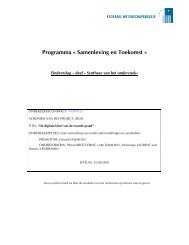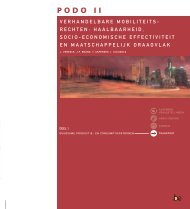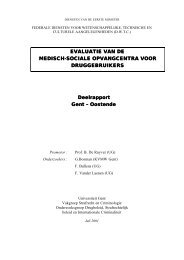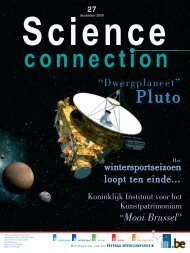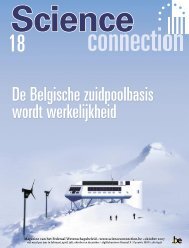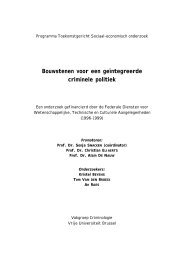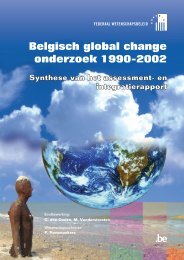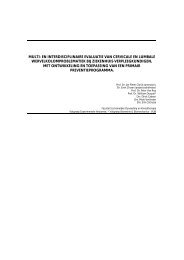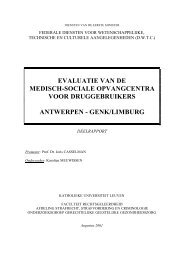chapter 3 inventory of local food systems
chapter 3 inventory of local food systems
chapter 3 inventory of local food systems
You also want an ePaper? Increase the reach of your titles
YUMPU automatically turns print PDFs into web optimized ePapers that Google loves.
Project CP/59 - “Instruments and institutions to develop <strong>local</strong> <strong>food</strong> <strong>systems</strong>”<br />
• Storage energy uses and CO2 emissions are respectively calculated base on<br />
calculation tables <strong>of</strong> the FCPT (Verlinden, 2002) and on the electricity production<br />
figures in van Essen et.al. (2003), both in combination with data specific to the studied<br />
<strong>food</strong> <strong>systems</strong> e.g.: type <strong>of</strong> cold store, storage time, etc.<br />
• The average storage time and type <strong>of</strong> cold store (regular cooling or ULO-cooling)<br />
that the farmers indicated during these interviews is used to calculate the storage energy<br />
use and CO2 emission. No energy is used to cool the apples on the way to the farmers’<br />
markets and on the market itself, except on very hot days, but this extra cooling is not<br />
included in the calculations.<br />
• For the mainstream <strong>food</strong> system the storage period used in calculations is the<br />
same as in the LFS, but all apples are assumed to be stored in ULO-cool stores. Extra<br />
cooling in the different stages after the ULO-storage (at the auction, in the distribution<br />
centre and the supermarket) is considered as regular cooling and comparable to the<br />
cooling used at the auction, with a total cooling period <strong>of</strong> 7 days.<br />
Specifically for vegetables and potatoes<br />
• For transport energy use and CO2 emission in the LFS, data are based <strong>of</strong> the<br />
amounts <strong>of</strong> cabbage lettuce, tomatoes, carrots and potatoes that were put in the box<br />
schemes during the year 2004, taking into account the number <strong>of</strong> times a specific <strong>food</strong><br />
item was put in the box and thus transported. Products in these box scheme are mainly<br />
own production (1), but also from associate farmers (2) and in some cases from a<br />
biological wholesaler (3) dropping <strong>of</strong>f these product at the farm in a drop-<strong>of</strong>f round.<br />
Percentages <strong>of</strong> each <strong>of</strong> the three ways <strong>of</strong> obtaining the products are calculated and<br />
multiplied by the matching energy uses and CO2 emissions to get a result as close to<br />
reality as possible.<br />
• The average weight <strong>of</strong> a medium vegetable box is estimated to be between 3 and<br />
4 kg. In reality there are large seasonal differences and also small, medium and large<br />
vegetable boxes and separate potato boxes in the LFS studied.<br />
• Storage energy use is also calculated base on calculation tables <strong>of</strong> the FCPT<br />
(Verlinden, 2002), in combination with data specific to the studied <strong>food</strong> <strong>systems</strong> e.g.<br />
storage time.<br />
• For the <strong>local</strong> <strong>food</strong> <strong>systems</strong>, the average storage time that the farmers indicated in<br />
the interviews was 1 to 1.5 days. Because <strong>of</strong> unavailable data on small cool stores, the<br />
figures from the FCPT (Verlinden, 2002) are used and multiplied by a factor 1.5 in the<br />
calculations <strong>of</strong> storage energy use and CO2 emissions. This factor 1.5 is utilized based<br />
on personal communication with experts from the FCPT. No energy is used to cool the<br />
vegetables on the way to the consumers collecting point and at the collecting point<br />
itself.<br />
• For the mainstream <strong>food</strong> system the total storage period (on farm, at the auction,<br />
in the distribution centre and the supermarket) used in calculations is considered as one<br />
SPSD II - Part I - Sustainable production and consumption patterns - Agro-Food 54



